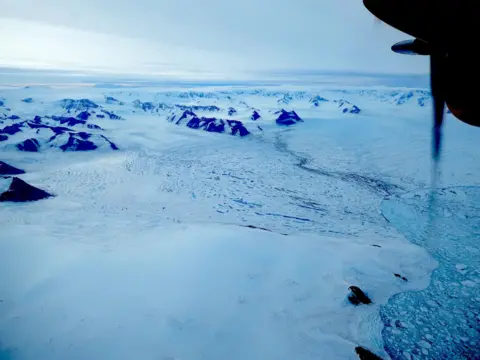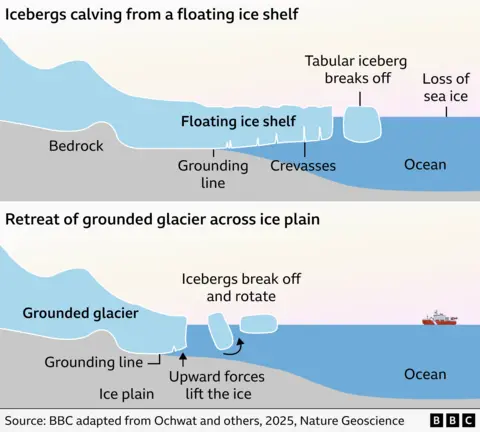Mark PoyntingClimate and science reporter, BBC News
 Naomi Ochwat
Naomi OchwatThe recent rapid retreat of an Antarctic glacier could be unprecedented, a new study suggests, a finding which could have major implications for future sea-level rise.
The researchers found that Hektoria Glacier retreated by more than 8km (5 miles) in just two months in late 2022.
The authors believe it could be the first modern example of a process where the front of a glacier resting on the seabed rapidly destabilises.
But other scientists argue that this part of the glacier was actually floating in the ocean – so while the changes are impressive, they are not so unusual.
Floating tongues of glaciers extending into the sea – called ice shelves – are much more prone to breaking up than glacier fronts resting on the seabed.
That’s because they can be more easily eaten away by warm water underneath.
Solving the ‘whodunnit’
That Hektoria has undergone huge change is not contested. Its front retreated by about 25km (16 miles) between January 2022 and March 2023, satellite data shows.
But unravelling the causes is like a “whodunnit” mystery, according to study lead author Naomi Ochwat, research affiliate at the University of Colorado Boulder and post-doctoral researcher at the University of Innsbruck.
The case began way back in 2002 with the extraordinary collapse of an ice shelf called Larsen B in the eastern Antarctic Peninsula. About 3250 sq km (1250 sq miles) of ice shelf was lost, roughly the size of Cambridgeshire or Gloucestershire.
Larsen B had been effectively holding Hektoria Glacier back. Without it, Hektoria’s movement sped up and the glacier thinned.
But the bay vacated by the ice shelf was eventually filled with sea-ice “fastened” to the seabed, helping to partly stabilise Hektoria.
That was until early 2022, when the sea-ice broke up.
 British Antarctic Survey
British Antarctic SurveyWhat followed was further loss of floating ice from the front of Hektoria, as large, flat-topped icebergs broke off or “calved”, and the ice behind sped up and thinned.
That is not unusual. Iceberg calving is a natural part of ice sheet behaviour, even though human-caused climate change makes the loss of ice shelves much more likely.
What was unprecedented, the authors argue, was what happened in late 2022, when they suggest the front of the glacier was “grounded” – resting on the seabed – rather than floating.
In just two months, Hektoria retreated by 8.2km. That would be nearly ten times faster than any grounded glacier recorded before, according to the study, published in Nature Geoscience.

This extraordinary change, the authors say, could be thanks to an ice plain – a relatively flat area of bedrock on which the glacier lightly rests.
Upward forces from the ocean water could “lift” the thinning ice essentially all at once, they argue – causing icebergs to break off and the glacier to retreat in quick time.
“Glaciers don’t usually retreat this fast,” said co-author Adrian Luckman, professor of geography at Swansea University.
“The circumstances may be a little particular, but this rapid retreat shows us what may happen elsewhere in Antarctica where glaciers are lightly grounded, and sea-ice loses its grip,” he added.

What makes this idea even more tantalising is that this process has never been observed in the modern world, the authors say. But markings on the seafloor suggest it may have triggered rapid ice loss into the ocean in the Earth’s past.
“What we see at Hektoria is a small glacier, but if something like that were to happen in other areas of Antarctica, it could play a much larger role in the rate of sea-level rise,” said Dr Ochwat.
That could include Thwaites – the so-called “doomsday” glacier because it holds enough ice to raise global sea-levels by 65cm (26in) if it melted entirely.
“It’s really important to understand whether or not there are other ice plain areas that would be susceptible to this kind of retreat and calving,” Dr Ochwat added.
Other scientists unconvinced
But other researchers have contested the study’s findings.
The controversy surrounds the position of the “grounding line” or “grounding zone” – where the glacier loses contact with the seabed and starts to float in the ocean.
“This new study offers a tantalising glimpse into what could be the fastest rate of retreat ever observed in modern-day Antarctica,” said Dr Frazer Christie, glaciologist and senior Earth observation specialist at Airbus Defence and Space.
“But there is significant disagreement within the glaciological community about the precise location of Hektoria Glacier’s grounding line because it’s so difficult to get accurate records from radar satellites in this fast-flowing region,” he added.
The location of the grounding line may sound trivial, but it is crucial to determine whether the change was truly unprecedented.
“If this section of the ice sheet was in fact floating [rather than resting on the seabed], the punchline would instead be that icebergs calved from an ice shelf, which is much less unusual behaviour,” said Dr Christine Batchelor, senior lecturer in physical geography at Newcastle University.
“I think the mechanism and rate of retreat proposed are plausible in Antarctic ice plain settings, but because of uncertainty about where the grounding zone was located at Hektoria, I am not fully convinced that this has been observed here,” she added.
But where there is little debate is that the fragile white continent – once thought largely immune from the impacts of global warming – is now changing before our eyes.
“While we disagree about the process driving this change at Hektoria, we are in absolute agreement that the changes in the polar regions are scarily rapid, quicker than we expected even a decade ago,” said Anna Hogg, professor of Earth observation at the University of Leeds.
“We must collect more data from satellites, so that we can better monitor and understand why these changes are occurring and what their implications are [for sea-level rise].”
Additional reporting by the Visual Journalism team



